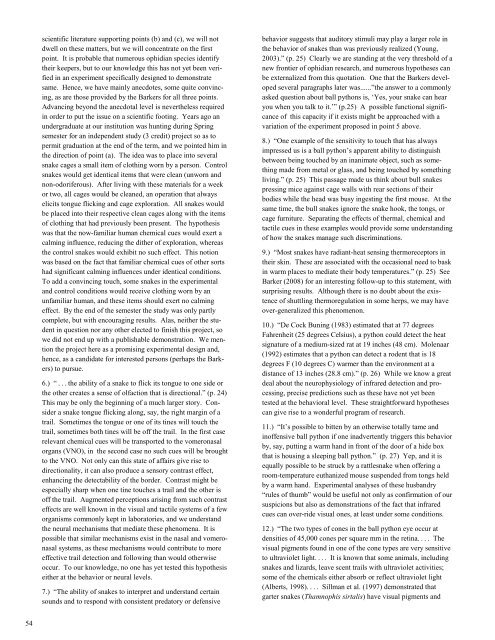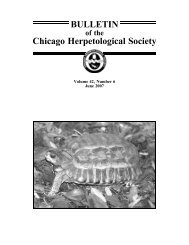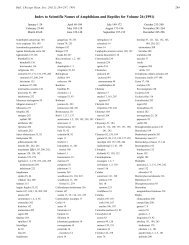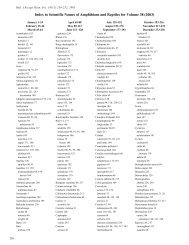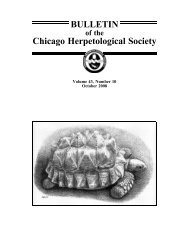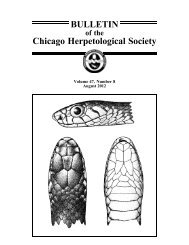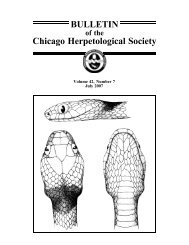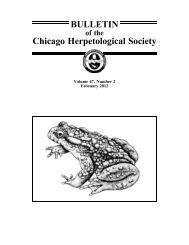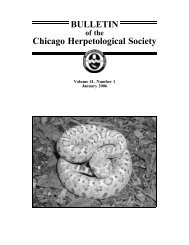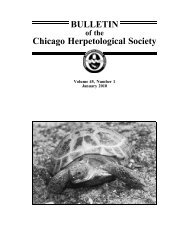April - Chicago Herpetological Society
April - Chicago Herpetological Society
April - Chicago Herpetological Society
Create successful ePaper yourself
Turn your PDF publications into a flip-book with our unique Google optimized e-Paper software.
scientific literature supporting points (b) and (c), we will not<br />
dwell on these matters, but we will concentrate on the first<br />
point. It is probable that numerous ophidian species identify<br />
their keepers, but to our knowledge this has not yet been verified<br />
in an experiment specifically designed to demonstrate<br />
same. Hence, we have mainly anecdotes, some quite convincing,<br />
as are those provided by the Barkers for all three points.<br />
Advancing beyond the anecdotal level is nevertheless required<br />
in order to put the issue on a scientific footing. Years ago an<br />
undergraduate at our institution was hunting during Spring<br />
semester for an independent study (3 credit) project so as to<br />
permit graduation at the end of the term, and we pointed him in<br />
the direction of point (a). The idea was to place into several<br />
snake cages a small item of clothing worn by a person. Control<br />
snakes would get identical items that were clean (unworn and<br />
non-odoriferous). After living with these materials for a week<br />
or two, all cages would be cleaned, an operation that always<br />
elicits tongue flicking and cage exploration. All snakes would<br />
be placed into their respective clean cages along with the items<br />
of clothing that had previously been present. The hypothesis<br />
was that the now-familiar human chemical cues would exert a<br />
calming influence, reducing the dither of exploration, whereas<br />
the control snakes would exhibit no such effect. This notion<br />
was based on the fact that familiar chemical cues of other sorts<br />
had significant calming influences under identical conditions.<br />
To add a convincing touch, some snakes in the experimental<br />
and control conditions would receive clothing worn by an<br />
unfamiliar human, and these items should exert no calming<br />
effect. By the end of the semester the study was only partly<br />
complete, but with encouraging results. Alas, neither the student<br />
in question nor any other elected to finish this project, so<br />
we did not end up with a publishable demonstration. We mention<br />
the project here as a promising experimental design and,<br />
hence, as a candidate for interested persons (perhaps the Barkers)<br />
to pursue.<br />
6.) “ . . . the ability of a snake to flick its tongue to one side or<br />
the other creates a sense of olfaction that is directional.” (p. 24)<br />
This may be only the beginning of a much larger story. Consider<br />
a snake tongue flicking along, say, the right margin of a<br />
trail. Sometimes the tongue or one of its tines will touch the<br />
trail, sometimes both tines will be off the trail. In the first case<br />
relevant chemical cues will be transported to the vomeronasal<br />
organs (VNO), in the second case no such cues will be brought<br />
to the VNO. Not only can this state of affairs give rise to<br />
directionality, it can also produce a sensory contrast effect,<br />
enhancing the detectability of the border. Contrast might be<br />
especially sharp when one tine touches a trail and the other is<br />
off the trail. Augmented perceptions arising from such contrast<br />
effects are well known in the visual and tactile systems of a few<br />
organisms commonly kept in laboratories, and we understand<br />
the neural mechanisms that mediate these phenomena. It is<br />
possible that similar mechanisms exist in the nasal and vomeronasal<br />
systems, as these mechanisms would contribute to more<br />
effective trail detection and following than would otherwise<br />
occur. To our knowledge, no one has yet tested this hypothesis<br />
either at the behavior or neural levels.<br />
7.) “The ability of snakes to interpret and understand certain<br />
sounds and to respond with consistent predatory or defensive<br />
behavior suggests that auditory stimuli may play a larger role in<br />
the behavior of snakes than was previously realized (Young,<br />
2003).” (p. 25) Clearly we are standing at the very threshold of a<br />
new frontier of ophidian research, and numerous hypotheses can<br />
be externalized from this quotation. One that the Barkers developed<br />
several paragraphs later was......”the answer to a commonly<br />
asked question about ball pythons is, ‘Yes, your snake can hear<br />
you when you talk to it.’” (p.25) A possible functional significance<br />
of this capacity if it exists might be approached with a<br />
variation of the experiment proposed in point 5 above.<br />
8.) “One example of the sensitivity to touch that has always<br />
impressed us is a ball python’s apparent ability to distinguish<br />
between being touched by an inanimate object, such as something<br />
made from metal or glass, and being touched by something<br />
living.” (p. 25) This passage made us think about bull snakes<br />
pressing mice against cage walls with rear sections of their<br />
bodies while the head was busy ingesting the first mouse. At the<br />
same time, the bull snakes ignore the snake hook, the tongs, or<br />
cage furniture. Separating the effects of thermal, chemical and<br />
tactile cues in these examples would provide some understanding<br />
of how the snakes manage such discriminations.<br />
9.) “Most snakes have radiant-heat sensing thermoreceptors in<br />
their skin. These are associated with the occasional need to bask<br />
in warm places to mediate their body temperatures.” (p. 25) See<br />
Barker (2008) for an interesting follow-up to this statement, with<br />
surprising results. Although there is no doubt about the existence<br />
of shuttling thermoregulation in some herps, we may have<br />
over-generalized this phenomenon.<br />
10.) “De Cock Buning (1983) estimated that at 77 degrees<br />
Fahrenheit (25 degrees Celsius), a python could detect the heat<br />
signature of a medium-sized rat at 19 inches (48 cm). Molenaar<br />
(1992) estimates that a python can detect a rodent that is 18<br />
degrees F (10 degrees C) warmer than the environment at a<br />
distance of 13 inches (28.8 cm).” (p. 26) While we know a great<br />
deal about the neurophysiology of infrared detection and processing,<br />
precise predictions such as these have not yet been<br />
tested at the behavioral level. These straightforward hypotheses<br />
can give rise to a wonderful program of research.<br />
11.) “It’s possible to bitten by an otherwise totally tame and<br />
inoffensive ball python if one inadvertently triggers this behavior<br />
by, say, putting a warm hand in front of the door of a hide box<br />
that is housing a sleeping ball python.” (p. 27) Yep, and it is<br />
equally possible to be struck by a rattlesnake when offering a<br />
room-temperature euthanized mouse suspended from tongs held<br />
by a warm hand. Experimental analyses of these husbandry<br />
“rules of thumb” would be useful not only as confirmation of our<br />
suspicions but also as demonstrations of the fact that infrared<br />
cues can over-ride visual ones, at least under some conditions.<br />
12.) “The two types of cones in the ball python eye occur at<br />
densities of 45,000 cones per square mm in the retina. . . . The<br />
visual pigments found in one of the cone types are very sensitive<br />
to ultraviolet light. . . . It is known that some animals, including<br />
snakes and lizards, leave scent trails with ultraviolet activities;<br />
some of the chemicals either absorb or reflect ultraviolet light<br />
(Alberts, 1998). . . . Sillman et al. (1997) demonstrated that<br />
garter snakes (Thamnophis sirtalis) have visual pigments and<br />
54


